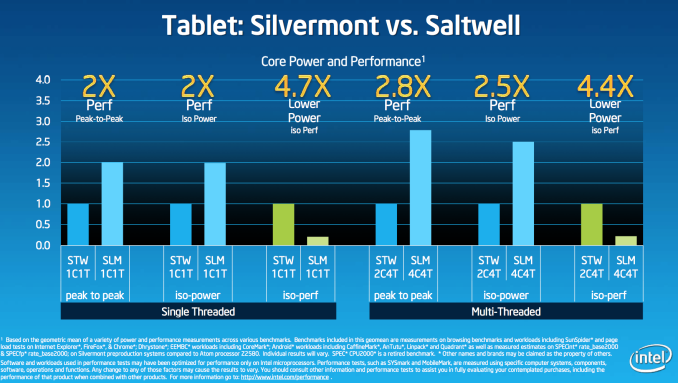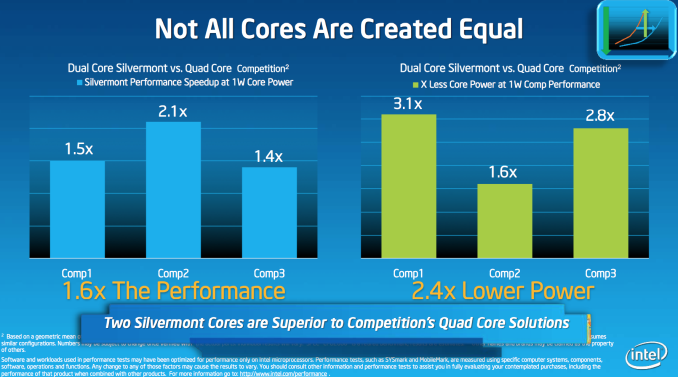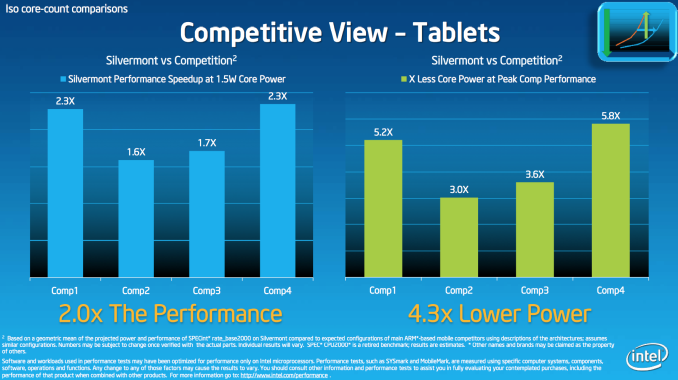Intel’s Silvermont Architecture Revealed: Getting Serious About Mobile
by Anand Lal Shimpi on May 6, 2013 1:00 PM EST- Posted in
- CPUs
- Intel
- Silvermont
- SoCs
Tablet Expectations
Intel is getting architectural details about Silvermont launch ahead of actual SoCs based on the CPU. Baytrail tablets based on Silvermont cores are currently in development and are expected to show up by the end of the year. The Silvermont story at the end of this year should be a lot better than Clovertrail last year. Windows 8 will be in its second major revision (codename Windows Blue) and Intel will launch with both Android and Windows tablet availability. The inclusion of Android is very important to hitting lower price points, something Clovertrail really didn’t have last year. We should see Baytrail based tablets span the gamut of Nexus 7 to iPad pricing, with Haswell picking up where Silvermont ends.
Form factors should be no thicker than Clovertrail based designs, although it will be possible to go thinner with Baytrail/Silvermont should an OEM decide to. Displays should also be a lot better this time around. Intel is working with some OEMs on color calibration, an important step forward as I’m hearing Qualcomm will be doing the same with Snapdragon 800. We’ll also finally see resolutions higher than 1366x768, including potentially some competition for the iPad with Retina Display. Silvermont’s new system agent should do a good job of prioritizing GPU access to main memory in these ultra high resolution scenarios.
Performance
With tablets still months away from being production ready, there’s nothing for us to publicly test. Intel did share some of its own numbers off of its Baytrail reference tablet however, and they are impressive.
All of the Intel comparisons report the geometric mean performance advantage over a spectrum of benchmarks. The benchmarks used include SPECint2K, CoreMark, SunSpider, web page load tests in IE/Chrome/Firefox, Linpack, AnTuTu and Quadrant (ugh) among others. The point here isn’t to demonstrate absolute peak performance in one benchmark, but to instead give us a general idea of the sorts of gains we should expect to see from Silvermont/Baytrail tablets vs the competition. It’s an admirable effort and honestly the right way to do things (short of actually giving us a pre-production tablet to test that is). We’ll start with a comparison to Saltwell, the previous-generation 32nm Atom core. The Saltwell results are listed as STW while Silvermont is abbreviated SLM:
In terms of absolute performance, Silvermont’s peak single threaded performance is 2x that of Saltwell. This 2x gain includes IPC and clock frequency gains (only 50% is from IPC, the rest is due to IDI, system agent and frequency). Given that Saltwell is competitive with existing architectures from ARM and Qualcomm (except for the Cortex A15), a 2x increase in single threaded performance should put Silvermont in a leadership position when it arrives later this year.
The next set of bars is just as important. At the same power levels (Intel didn’t disclose specifically at what power), Silvermont delivers 2x the performance of Saltwell. Finally, at the same performance level, Silvermont uses 4.7x lower power. Given that Saltwell wasn’t terrible on power to begin with, this is very impressive. Without knowing the specific power and performance levels however, I wouldn’t draw too many conclusions based on this data though.
The multithreaded advantages are obviously even greater as Silvermont will be featured in quad-core configurations while Saltwell topped out at dual-core (4 threads) in tablets.
In the next two slides, Intel did some competitive analysis with Silvermont vs. the ARM based competition. The benchmarks are the same, but now we have specifics about power usage. In the first test Intel is comparing to three competitors all with quad-core designs. Intel claims to have estimated performance gains based on what is expected to be in the market by the end of this year. Intel’s performance modeling group is very good at what it does, but as with any estimate you always have to exercise some caution in buying the data until we have physical hardware in hand.
Intel isn’t naming the three competitors in this chart, but there are only a finite number of quad-core ARM players shipping in decent tablet designs these days. The chart on the left compares performance of a dual-core Silvermont to quad-core ARM based designs at a 1W core power level. This comparison is extremely important because it’s effectively demonstrating the type of advantage Intel hopes to have in smartphones next year.
The chart on the right fixes performance and shows the reduction in core power. Do keep in mind that there can be a big difference between core and device level power, although Intel does expect to be very competitive on battery life this round.
The final performance comparison slide increases max core power to 1.5W and compares quad-core Silvermont to the quad-core competition. You’ll note the arrival of a new competitor here. One of the bars is a dual-core SoC with its performance scaled to four cores. I’m less confident about that particular estimation simply because it assumes Apple won’t significantly update architectures in its next generation of iPads.
The performance deltas here are huge. If we assume that at least one of these bars represents a Cortex A15 based design, Silvermont looks very good.
That’s the end of the Intel data, but I have some thoughts to add. First of all, based on what I’ve seen and heard from third parties working on Baytrail designs - the performance claims of being 2x the speed of Clovertrail are valid. Compared to the two Cortex A15 designs I’ve tested (Exynos 5250, dual-core A15 @ 1.7GHz and Exynos 5410 quad-core A15 @ 1.6GHz), quad-core Silvermont also comes out way ahead. Intel’s claims of a 60% performance advantage, at minimum, compared to the quad-core competition seems spot on based on the numbers I’ve seen. Power is the only area that I can’t validate based on what I’ve seen already (no one has given me a Baytrail tablet to measure power on). Given what we know about Silvermont’s architecture and the gains offered by Intel’s 22nm process, I do expect this core to do better on power than what we’ve seen thus far from ARM’s Cortex A15.
There is something we aren’t taking into account though. As of now, the only Cortex A15 based SoCs that we’ve seen have been very leaky designs optimized for high frequency. Should an SoC vendor choose to optimize for power consumption instead, we could see a narrower gap between the power consumption of Cortex A15 and Silvermont. Obviously you give up performance when you do that, so it may not ultimately change anything - but the power story might be less of a blowout.













174 Comments
View All Comments
Jumangi - Monday, May 6, 2013 - link
Let me know when Intel has something of actual substance to show and not just bunch of marketing/hype focused Powerpoint slides. ARM continues to delivers solid performance gains year after year with low power usage...Intel says yea we'll will get around to updating our 5 year old design...eventually we promise...yawn...Krysto - Monday, May 6, 2013 - link
Great point. Intel keeps promising how awesome they will be when they launch their new "mobile" chip, and at always it's ALWAYS disappointing, because in the mean time ARM chips keep shipping on their merry way, and keep improving. Fast.A5 - Monday, May 6, 2013 - link
Eh. A15 wasn't exactly a home run. The performance is good for what it is, but they overshot their TDP targets big time.saurabhr8here - Monday, May 6, 2013 - link
A15 wasn't a home run because it has been developed on an early bleeding edge technology. As the process technology matures and the design is optimized for the process, the power/performance numbers will improve.DanNeely - Tuesday, May 7, 2013 - link
A15's problem isn't overshooting TDP targets; it's that it was originally designed for use in entry level NASes and other similar level embedded systems/micro servers. A few extra watts for better CPU performance isn't a big problem there.xTRICKYxx - Tuesday, May 7, 2013 - link
Exactly. A15 was not initially designed for smartphones.Wilco1 - Tuesday, May 7, 2013 - link
That's not correct, ARM has said from the early announcements that it would go into mobiles at lower frequencies and core counts. Of course both core counts and frequencies turned out to be higher than originally expected, so power consumption is higher too. The Exynos 5250 appears to be released quickly in order to be first to market. The Octa core is far more tuned and will do better. NVidia has stated Tegra 4 uses 40% less power than Tegra 3 at equivalent performance levels.Krysto - Monday, May 6, 2013 - link
Let's do a recap. Performance is as high as Cortex A15...a chip launched in 2012.GPU performance is where iPad 4 was...in 2012.
They are doing their benchmarks against last-gen ARM chips...okay.
Intel Silvermont is expected late 2013/early 2014.
Yeah...it's obviously so competitive! NOT.
By the time Intel Silvermont arrives in smartphones (Merrifield), we will see 20nm ARMv8 chips in smartphones, already shipping. Good luck, Intel, another hit and a miss.
As for what you said that Silvermont is conservative because they don't want to basically cannibalize Haswell - that's EXACTLY Intel's biggest problem right now. Their conflict of interest between the low-end, unprofitable Atom division, with the high-end very profitable Core division.
This is exactly what killed their Xscale division, too. And it's what will kill Intel in the end. Because Intel will have to make Atom compete *whether they want to or not*. ARM chips are going to go higher and higher performance and become "good enough" for most everything. What is Intel going to do then? They'll have to keep up, which will slowly eliminate their *profitable* Core chips from the market. And what then? Survive on $20 chips with a dozen competitors? This is going to be very interesting for Intel in the next few years - and not in a good way, especially with a brand new CEO.
Kjella - Monday, May 6, 2013 - link
It's been four months of 2013, how many quad-core ARM processors have launched since 2012? They're comparing against what is out now (if they were able to compare against unreleased ARM processors there'd be something very wrong) and beating them, not sure where your reading comprehension failed there. Looks to me like they're ready for a clash of the titans around year's end. Also 1-5W chips don't compete much with 15-85W Haswells no matter what, AMD is dying fast and people need their x86 computers so whatever. Reminds me of all the posts that say Windows is sooooooo dead.xTRICKYxx - Tuesday, May 7, 2013 - link
AMD is making a lot of money right now.